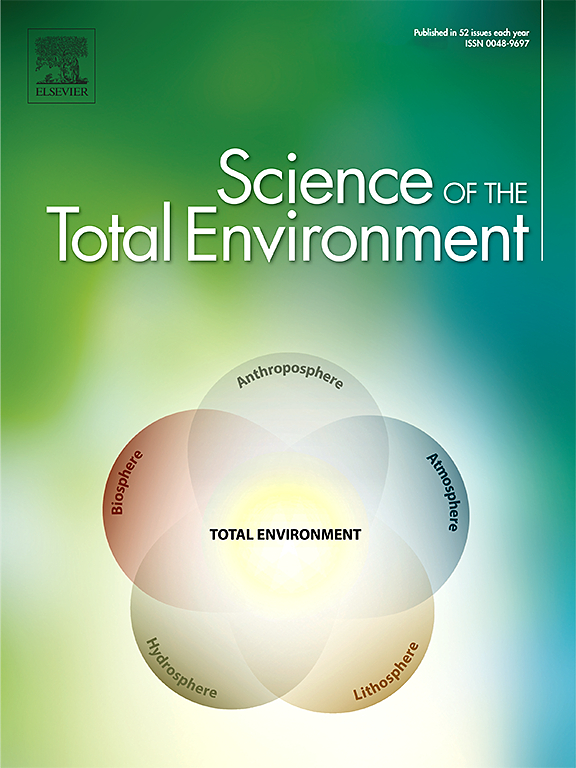Analysis of contaminants in surface water after the collapse of the Córrego do Feijão mine dam in Brumadinho, Brazil
IF 8.2
1区 环境科学与生态学
Q1 ENVIRONMENTAL SCIENCES
引用次数: 0
Abstract
This manuscript presents results on surface water quality in the Paraopeba River basin, Brazil, following the environmental disaster caused by the dam collapse at the Córrego do Feijão mine in Brumadinho. Surface water samples were collected at 52 points along the river and analyzed to determine the presence of organic compounds according to the guidelines outlined in CONAMA Resolution 396. Liquid and gas chromatography with sequential mass spectrometry (UHPLC-2D-MS/MS and GC–MS/MS, respectively) were employed to identify and quantify volatile, semi-volatile, and non-volatile organic compounds in the water samples. The results revealed the presence of several organic compounds, some of which exceeded the maximum allowable concentrations. Most semi-volatile compounds analyzed were within regulatory limits, although some were near the maximum permissible thresholds. Polycyclic aromatic hydrocarbons (PAHs), including Benzo(a)anthracene, Benzo(a)pyrene, and Chrysene, were found at concentrations indicative of combustion residues. Additionally, pesticide residues such as organophosphates and triazines were quantified, pointing to agricultural influence in the basin. Organochlorine compounds banned in Brazil, such as dieldrin, aldrin, DDT, and lindane, were still detected in the samples, evidencing their environmental persistence. The compounds with the highest detection frequencies were 2,4,6-trichlorophenol (415 samples), pentachlorophenol (259 samples), and lindane (188 samples). Peak concentrations were observed for 2,4,6-trichlorophenol (11.0 μg L−1), cis-dichloroethene (82.2 μg L−1), trans-dichloroethene (10.3 μg L−1), and alachlor (6.2 μg L−1), raising concerns about their persistence and potential toxicity. These findings highlight the importance of continuously monitoring surface water quality in areas affected by environmental disasters to ensure the safety of water consumers.

巴西布鲁马迪尼奥Córrego do feij矿坝坍塌后地表水中的污染物分析
本文介绍了Brumadinho Córrego do feij o矿山溃坝造成的环境灾难后,巴西Paraopeba河流域地表水质量的结果。根据CONAMA第396号决议概述的指导方针,在沿河的52个地点收集了地表水样本,并进行了分析,以确定是否存在有机化合物。采用液相和气相串联质谱法(分别为UHPLC-2D-MS/MS和GC-MS /MS)对水样中的挥发性、半挥发性和非挥发性有机化合物进行鉴定和定量。结果显示,有几种有机化合物的存在,其中一些超过了最大允许浓度。分析的大多数半挥发性化合物都在规定限度内,尽管有些接近最大允许阈值。多环芳烃(PAHs),包括苯并(a)蒽、苯并(a)芘和甲苯,其浓度表明燃烧残留物。此外,对有机磷和三嗪等农药残留进行了量化,指出了该流域的农业影响。在巴西被禁用的有机氯化合物,如狄氏剂、艾氏剂、滴滴涕和林丹,仍在样品中检测到,证明它们在环境中的持久性。检测频率最高的化合物为2,4,6-三氯苯酚(415份)、五氯苯酚(259份)和林丹(188份)。2,4,6-三氯酚(11.0 μg L−1)、顺式二氯乙烯(82.2 μg L−1)、反式二氯乙烯(10.3 μg L−1)和甲草胺(6.2 μg L−1)的浓度达到峰值,引起了人们对它们的持久性和潜在毒性的担忧。这些发现突出了在受环境灾害影响的地区持续监测地表水质量以确保水消费者安全的重要性。
本文章由计算机程序翻译,如有差异,请以英文原文为准。
求助全文
约1分钟内获得全文
求助全文
来源期刊

Science of the Total Environment
环境科学-环境科学
CiteScore
17.60
自引率
10.20%
发文量
8726
审稿时长
2.4 months
期刊介绍:
The Science of the Total Environment is an international journal dedicated to scientific research on the environment and its interaction with humanity. It covers a wide range of disciplines and seeks to publish innovative, hypothesis-driven, and impactful research that explores the entire environment, including the atmosphere, lithosphere, hydrosphere, biosphere, and anthroposphere.
The journal's updated Aims & Scope emphasizes the importance of interdisciplinary environmental research with broad impact. Priority is given to studies that advance fundamental understanding and explore the interconnectedness of multiple environmental spheres. Field studies are preferred, while laboratory experiments must demonstrate significant methodological advancements or mechanistic insights with direct relevance to the environment.
 求助内容:
求助内容: 应助结果提醒方式:
应助结果提醒方式:


